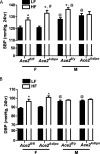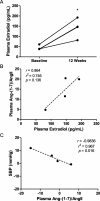Adipocyte deficiency of ACE2 increases systolic blood pressures of obese female C57BL/6 mice
- PMID: 31484552
- PMCID: PMC6727421
- DOI: 10.1186/s13293-019-0260-8
Adipocyte deficiency of ACE2 increases systolic blood pressures of obese female C57BL/6 mice
Abstract
Background: Obesity increases the risk for hypertension in both sexes, but the prevalence of hypertension is lower in females than in males until menopause, despite a higher prevalence of obesity in females. We previously demonstrated that angiotensin-converting enzyme 2 (ACE2), which cleaves the vasoconstrictor, angiotensin II (AngII), to generate the vasodilator, angiotensin-(1-7) (Ang-(1-7)), contributes to sex differences in obesity-hypertension. ACE2 expression in adipose tissue was influenced by obesity in a sex-specific manner, with elevated ACE2 expression in obese female mice. Moreover, estrogen stimulated adipose ACE2 expression and reduced obesity-hypertension in females. In this study, we hypothesized that deficiency of adipocyte ACE2 contributes to obesity-hypertension of females.
Methods: We generated a mouse model of adipocyte ACE2 deficiency. Male and female mice with adipocyte ACE2 deficiency or littermate controls were fed a low (LF) or a high fat (HF) diet for 16 weeks and blood pressure was quantified by radiotelemetry. HF-fed mice of each sex and genotype were challenged by an acute AngII injection, and blood pressure response was quantified. To translate these findings to humans, we performed a proof-of-principle study in obese transwomen in which systemic angiotensin peptides and blood pressure were quantified prior to and after 12 weeks of gender-affirming 17β-estradiol hormone therapy.
Results: Adipocyte ACE2 deficiency had no effect on the development of obesity in either sex. HF feeding increased systolic blood pressures (SBP) of wild-type male and female mice compared to LF-fed controls. Adipocyte ACE2 deficiency augmented obesity-induced elevations in SBP in females, but not in males. Obese female, but not obese male mice with adipocyte ACE2 deficiency, had an augmented SBP response to acute AngII challenge. In humans, plasma 17β-estradiol concentrations increased in obese transwomen administered 17β-estradiol and correlated positively with plasma Ang-(1-7)/AngII balance, and negatively to SBP after 12 weeks of 17β-estradiol administration.
Conclusions: Adipocyte ACE2 protects female mice from obesity-hypertension, and reduces the blood pressure response to systemic AngII. In obese transwomen undergoing gender-affirming hormone therapy, 17β-estradiol administration may regulate blood pressure via the Ang-(1-7)/AngII balance.
Keywords: Angiotensin-(1-7); Angiotensin-converting enzyme 2; Blood pressure; Obesity; Transgender.
Conflict of interest statement
The authors decalare that they have no competing interests.
Figures





Similar articles
-
Angiotensin converting enzyme 2 contributes to sex differences in the development of obesity hypertension in C57BL/6 mice.Arterioscler Thromb Vasc Biol. 2012 Jun;32(6):1392-9. doi: 10.1161/ATVBAHA.112.248559. Epub 2012 Mar 29. Arterioscler Thromb Vasc Biol. 2012. PMID: 22460555 Free PMC article.
-
Administration of 17β-estradiol to ovariectomized obese female mice reverses obesity-hypertension through an ACE2-dependent mechanism.Am J Physiol Endocrinol Metab. 2015 Jun 15;308(12):E1066-75. doi: 10.1152/ajpendo.00030.2015. Epub 2015 Apr 14. Am J Physiol Endocrinol Metab. 2015. PMID: 26078188 Free PMC article.
-
Differential effects of Mas receptor deficiency on cardiac function and blood pressure in obese male and female mice.Am J Physiol Heart Circ Physiol. 2017 Mar 1;312(3):H459-H468. doi: 10.1152/ajpheart.00498.2016. Epub 2016 Dec 16. Am J Physiol Heart Circ Physiol. 2017. PMID: 27986659 Free PMC article.
-
ACE2 and vasoactive peptides: novel players in cardiovascular/renal remodeling and hypertension.Ther Adv Cardiovasc Dis. 2015 Aug;9(4):217-37. doi: 10.1177/1753944715597623. Epub 2015 Aug 13. Ther Adv Cardiovasc Dis. 2015. PMID: 26275770 Review.
-
The Pivotal Role of Adipocyte-Na K peptide in Reversing Systemic Inflammation in Obesity and COVID-19 in the Development of Heart Failure.Antioxidants (Basel). 2020 Nov 14;9(11):1129. doi: 10.3390/antiox9111129. Antioxidants (Basel). 2020. PMID: 33202598 Free PMC article. Review.
Cited by
-
Does Sex Matter in Obesity-Induced Periodontal Inflammation in the SSLepR Mutant Rats?Dent J (Basel). 2024 Dec 27;13(1):14. doi: 10.3390/dj13010014. Dent J (Basel). 2024. PMID: 39851590 Free PMC article.
-
Male bias in ACE2 basic science research: missed opportunity for discovery in the time of COVID-19.Am J Physiol Regul Integr Comp Physiol. 2021 Jun 1;320(6):R925-R937. doi: 10.1152/ajpregu.00356.2020. Epub 2021 Apr 13. Am J Physiol Regul Integr Comp Physiol. 2021. PMID: 33848207 Free PMC article. Review.
-
Coronavirus Receptors as Immune Modulators.J Immunol. 2021 Mar 1;206(5):923-929. doi: 10.4049/jimmunol.2001062. Epub 2020 Dec 30. J Immunol. 2021. PMID: 33380494 Free PMC article. Review.
-
COVID-19 and RAS: Unravelling an Unclear Relationship.Int J Mol Sci. 2020 Apr 24;21(8):3003. doi: 10.3390/ijms21083003. Int J Mol Sci. 2020. PMID: 32344526 Free PMC article.
-
Angiotensin-converting enzyme 2 and COVID-19: patients, comorbidities, and therapies.Am J Physiol Lung Cell Mol Physiol. 2021 Mar 1;320(3):L301-L330. doi: 10.1152/ajplung.00259.2020. Epub 2020 Nov 25. Am J Physiol Lung Cell Mol Physiol. 2021. PMID: 33237815 Free PMC article. Review.
References
-
- Hales CM, Carroll MD, Fryar CD, Ogden CL. Prevalence of obesity among adults and youth: United States, 2015-2016. NCHS Data Brief. 2017;288:1–8. - PubMed
-
- Fryar CD, Ostchega Y, Hales CM, Zhang G, Kruszon-Moran D. Hypertension prevalence and control among adults: United States, 2015-2016. NCHS Data Brief. 2017;289:1–8. - PubMed
Publication types
MeSH terms
Substances
Grants and funding
LinkOut - more resources
Full Text Sources
Medical
Molecular Biology Databases
Research Materials
Miscellaneous

